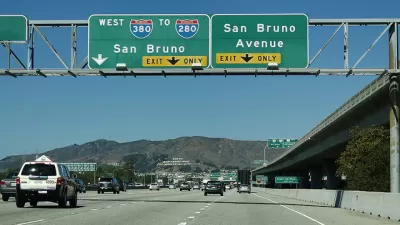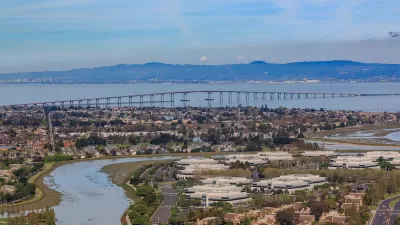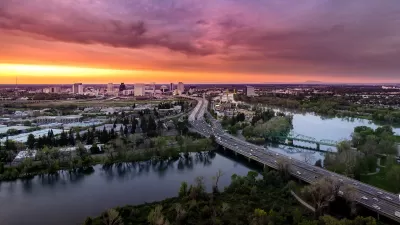Caltrans hopes to build two 14-mile high-occupancy toll lanes on Hwy 101 in San Mateo County, one of the region's most congested corridors that lacks carpool lanes. The $534 million project would begin construction in 2019.
Samantha Weigel reports for the San Mateo Daily Journal on a Dec. 11 public meeting [pdf] in San Mateo hosted by the state Department of Transportation (Caltrans) "as part of the drafting of the environmental document on which comments will be accepted through Jan. 19."
A map [png] of the area, along with fact sheets, presentations and the draft environmental impact report, released Nov. 20, are available on the Caltrans webpage, "SM 101 - Managed Lanes Project (MLP)." [SM stands for San Mateo County]. One new toll lane in each direction would start where the existing carpool lane bends at Whipple Avenue in Redwood City and go 14 miles north to the intersection with Interstate 380 in San Bruno just north of the San Francisco International Airport.
Reactions from the public were starkly different from a public meeting held on Dec. 7 in Colorado Springs to discuss a similar proposal by the Colorado Department of Transportation to widen an 18-mile stretch of Interstate 25 with one toll lane in each direction. Attendees largely expressed their outrage at having to pay to use the lane additions.
In San Mateo, "[a]ttendees were largely inquisitive," according to Weigel, though she does mention negative comments from prior meetings — that the express lane would benefit mainly wealthy drivers, although they would be free to 3+ carpools, hence the term high-occupancy toll (HOT) lanes, clean-air vehicles and motorcycles, or "that the additional space would be better utilized by extending popular mass transit such as BART along Highway 101."
Caltrans had good news regarding the need for additional space required for the express lane. Their engineering design shows that the project "will primarily stay within the state’s existing right-of-way and not require acquisition of any homes or businesses," writes Weigel.
Squeezing in space to widen the freeway includes narrowing some lanes from 12 feet to 11 feet, connecting existing auxiliary lanes while replacing heavily used ones, and relocating soundwalls in some areas. The project requires some right-of-way acquisition in San Mateo and Burlingame [confined to street frontage.]
The Daily Journal viewed this development favorably in their Nov. 22 editorial on the project.
While the verdict is out on toll roads since they benefit those who can afford them, creating a lane for buses [largely Google and other tech buses and shuttles] and carpools seems largely acceptable since there are already those on the highway lumbering along usually in the fast lane.
It would also provide a benefit to SamTrans, which is looking to expand its service along the highway...
The City/County Association of Governments and the San Mateo County Transportation Authority are partnering with Caltrans. It isn't clear, though, who would operate the lanes when completed, anticipated in the spring of 2019, as the Bay Area already has three operators:
- Metropolitan Transportation Commission
- Alameda County Transportation Commission
- Santa Clara Valley Transportation Commission
One attendee at the San Mateo meeting referenced Monday's article in the San Francisco Chronicle on the profitability of the I-580 Express Lanes in the East Bay.
“I read in the paper what happened with 580 and they’re just making [money] hand over fist with that and it seems to be working. So I think it would work here,” said Anne Merics, who has lived in Burlingame for more than four decades
However, most motorists actually pay to use those lanes, as noted by Planetizen, unlike the other two Bay Area express lane corridors where most vehicles either have clean-air stickers or qualify as carpools.
FULL STORY: Caltrans looks to fast-track managed lanes

Alabama: Trump Terminates Settlements for Black Communities Harmed By Raw Sewage
Trump deemed the landmark civil rights agreement “illegal DEI and environmental justice policy.”

Planetizen Federal Action Tracker
A weekly monitor of how Trump’s orders and actions are impacting planners and planning in America.

The 120 Year Old Tiny Home Villages That Sheltered San Francisco’s Earthquake Refugees
More than a century ago, San Francisco mobilized to house thousands of residents displaced by the 1906 earthquake. Could their strategy offer a model for the present?

Ken Jennings Launches Transit Web Series
The Jeopardy champ wants you to ride public transit.

BLM To Rescind Public Lands Rule
The change will downgrade conservation, once again putting federal land at risk for mining and other extractive uses.

Indy Neighborhood Group Builds Temporary Multi-Use Path
Community members, aided in part by funding from the city, repurposed a vehicle lane to create a protected bike and pedestrian path for the summer season.
Urban Design for Planners 1: Software Tools
This six-course series explores essential urban design concepts using open source software and equips planners with the tools they need to participate fully in the urban design process.
Planning for Universal Design
Learn the tools for implementing Universal Design in planning regulations.
Clanton & Associates, Inc.
Jessamine County Fiscal Court
Institute for Housing and Urban Development Studies (IHS)
City of Grandview
Harvard GSD Executive Education
Toledo-Lucas County Plan Commissions
Salt Lake City
NYU Wagner Graduate School of Public Service





























